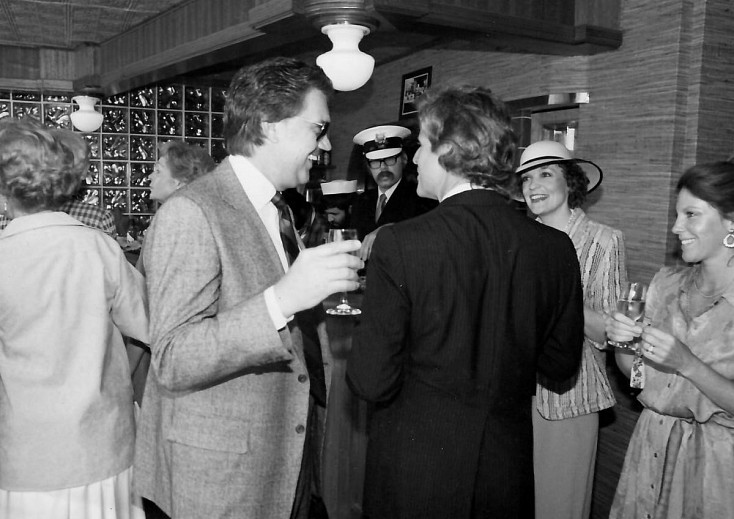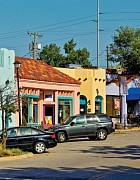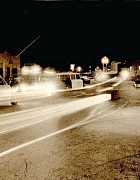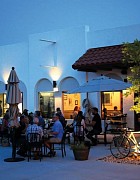




Blog: The Art of Resilience - Part II
July 23, 2020 - Joy Reed Belt
One of the great pleasures of my life with John Belt was watching him orchestrate the development of The Paseo Arts District. That idea was not fully formed when he initially purchased Hirams and some adjoining buildings along Paseo Drive. But it did not take him long to seize on the concept. He reasoned that Paseo was only two miles from downtown, where there was a high concentration of “art patrons.” The curvilinear and somewhat narrow Paseo Drive created a contained and walkable area. The human scale of the decorative buildings was well suited for galleries, artists’ studios and other compatible businesses.
As soon as the word got out that there was a man, who owned property in Paseo, and wanted to rent to artists, some wonderfully talented people started moving to the area, including Paul Wingo, Ernesto Compian, Bruce Marcellus, Claude Anderson, Lammy Wiseman, Mark Barker, George Oswalt, Reggie Jamie, Wayne and Bruce Buckner, Trey Haven, and Sharon Montgomery. The Oklahoma City Arts Council located their offices in Paseo for about ten years, before moving downtown.
By 1981, the buildings that John had purchased in the 1970’s were all listed on The National Register of Historic Places. In 1977, the residents and artists in The Paseo mounted “The Paseo Del Sol,” the first Paseo Arts Festival. This year, 2020, would have been our 44th Festival had we not had to cancel due to COVID. The Paseo Artists Association, PAA, was formed in 1981.
During the early 1980’s Oklahoma City was on a roll. The apartments in the Paseo neighborhood were bought by speculators, refurbished and promoted. At the same time real estate syndicates were building hundreds of economically insupportable apartments on the perimeters off the city. Urban Renewal began to destroy the Harrison Walnut area to make way for the Broadway Extension and the Health Science Center, displacing hundreds of economically disadvantaged families, many of whom relocated near and around The Paseo. In order to establish communication among a very diverse population, The Paseo Neighborhood Association was formed. The geographical boundaries were set between 23rd street in the South, 30th street on the North; Western on the West and Walker on the East.
When Penn Square Bank failed in 1982, massive layoffs occurred all over the city. The oil and gas industry collapsed, and the real estate market and banking industries nearly followed suit. Many of the houses in the Paseo Neighborhood and virtually all of the apartments were vacated by tenants who moved to the newly constructed apartments on the perimeter of the city, attracted by rents reduced to $175 a month. The studios and businesses on Paseo Drive demonstrated resilience and continued to improve, but the residential area surrounding it was devastated. Crime in the area became a very real problem.
In 1987, a consortium of the Neighborhood Alliance, The Neighborhood Association, the Spanish Village Redevelopment Association and the Paseo Artists Association, came together to undertake a revitalization of the entire Paseo Neighborhood (23rd Street to 30th Street and Walker to Western). Over the next three years, in cooperation with the City of Oklahoma and the help of many people, a plan was developed to address the problems of the central city, especially the Paseo Neighborhood, which was designated by the City as a pilot project, A/K/A Positively Paseo, to redevelop the area. The result of that effort is documented in its result. 1990 there were 135 boarded houses. In 2003 there were 17 boarded houses in the neighborhood. Today, I don’t know of any.
In 1990, Mike Larsen, the well-known Native American artist, moved his studio to 3001 Paseo. There, he worked on the murals that are hanging in the Rotunda of the Oklahoma State Capitol Building. Colin Rosebrook established Paseo Pottery at 3012 Paseo Drive. In 1993, Casa Rosa was remodeled to provide a stained-glass studio for Karen Hendrick and a fabric studio for Mary Beth Haas, where she created award winning quilts. Before becoming the principal designer for Six Flags Amusement Parks, Ron Roberts occupied a studio on Paseo from 1985 until 1995. In 1994, Kay Orr opened a teaching studio. In the same year, Laurie Keller opened a dance studio, “Once Upon A Star Dance Swan.” Sue Moss Sullivan, Winnie Hawkins, Regina Murphy, Donna Berryhill, Mary Nickel, and B. J. White opened Studio Six on the corner of NW 30th and Paseo Drive. Diane Coady began sharing space with Connie Hierlihe and photographer, Debra Von Swearingen. Michi Susan, the treasured Japanese/American artist, initially set up a studio in the Avalon Building before moving it to Casa Rosa.
In 1998, Debbie Michalke leased a studio where she created costumes for reenactment groups and theaters. I opened JRB Art on Paseo Drive in 1999, before moving to The Elms in 2001. Bob and Alma Hepp moved to a studio in Paseo in 2001 where he repaired and sculpted carousel horses until his death. In 2004, The Paseo neighborhood earned a spot on the National Register of Historical Places. That was the culmination of nearly a decade of hard work by its residents. To celebrate the resiliency and rebirth of The Paseo, John had all of the buildings he owned painted different colors.
In 2010, The Paseo was named one of America’s Top Ten Neighborhoods by the American Planning Association, as well as by Forbes Magazine. That same year, the BBC listed The Paseo as one of the most beautiful neighborhoods in the United States. The Paseo was the first neighborhood in Oklahoma to achieve those distinctions. In addition to the annual Paseo Arts Festival, which has become the second largest festival in the state, in 2003, Paseo started the popular First Friday Gallery Walks.
For the last ten years, Paseo has been enjoying another renaissance. In addition to attracting several very talented visual artists, the culinary arts have flourished. New restaurateurs are making their mark in The Paseo. Shaun Fiaconne and his Feed Humankind Restaurant Group opened Picasso’s and The Other Room in the building that over the years had once housed a funeral home, as well as several restaurants, including Hirams, Casa Blanca and Galileo’s. Humankind, also a partner in Sauced, developed vacant lots, built and operate two of the area’s new restaurants, OSO and Frida’s. Venerable Concepts, owned by Andrea Koestrel, John Otjen, and Josh Gautreaux opened “Holy Roller’s,” a donut and coffee shop, in The Plunge. They also renovated Oklahoma’s “oldest continuously operating bar and grill, The Red Rooster, at 30th and Walker. Shakespeare in The Park moved to Paseo and began having performances. Literati Bookstore opened in The Plunge. Denise Duong opened a studio on Paseo Drive. Betsy King’s Shoes and Eden’s Clothing and Accessories installed great retail shops that attract people to the area. And of course, Paseo Grill never disappoints. Until recently, Sheridan Scott Conrad made fine jewelry and sold it in her studio on the street. JRB Art at The Elms currently carries her work.
COVID 19 has changed how people all over the world, including The Paseo, live and work. It has been, and continues to be, amazing to watch how the concentration of creatives, who live and work in The Paseo, have addressed this issue. Not only has every challenge been met, but new ways of creating, experiencing and selling art have appeared. Also, strikingly innovative ways of getting food from a farm to your table has emerged. All though we all recognize that Covid is our contemporary Crucible, it has become apparent that it has also generated incubators of creativity. The Paseo Arts Association recently moved to a much larger space to accommodate their new Education and Creativity Center. Literati Books is doubling its space in the Plunge, Shakespeare in the Park is developing an outdoor site for performances, and a new glass shop will open on this next First Friday. Stay Tuned and Stay safe.
Images:
Left to Right: John Belt (light suit with profile to camera), Robert Hefner (dark suit with back to camera), Joy Reed Belt (light hat and facing camera), and Suzanne Mears (profile to camera) at Casablanca c. early 1980s
Paseo c. 1980s
Paseo c. 2000s
Sauced in Paseo
Oso's in Paseo
Download Article (PDF)Back to Blogs
